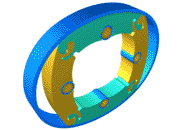
Quasiturbine
Pump and Turbo-pump
In the pump mode, the Quasiturbine has 2 intakes and 2 exits
related to 2 quasi-distinct circuits.
Each circuit can in principle be used in pneumatic or hydraulic mode,
or vacuum or pressure pump, for compressible or non-compressible fluids.
The Quasiturbine is a positive displacement pump, and not an aero- or
hydro-dynamic one.

Why is the Quasiturbine pump superior to conventional pump?
Linearity:
Compared to other rotary or piston pumps, the flow of the Quasiturbine is
relatively more linear in relation to the shaft angle rotation, which makes
potentially a better fuel flow controller...
High flow rate:
Each blade expels its volume when reaching on the top and the bottom, twice
per rotation. Since there are 4 blades, the flow is of 8 chambers per rotation,
which is more that 60% of the total rotor volume for certain geometry (assuming
that the 2 circuits are used in pump mode).
Low RPM:
The Quasiturbine is well suitable in the 0 to 1,000 RPM range, and
consequently the importance of the wear effects are moderated. The acceleration
or flow modulation are also better controlled.
Efficient at any flow rate:
Contrary to aero- or hydro-dynamic pumps which have an efficiency curve
limited to a narrow range (outside of which those pumps heat considerably the
liquid or the gas), the Quasiturbine pump conserve a high efficiency at all
rotational regime. At zero RPM, this pump can completely cut the flow.
Mixed Turbo-pump mode:
In pump mode, the Quasiturbine can be driven externally by its central shaft
(eventually by a Quasiturbine engine). However, the 2 quasi-independents
circuits can in certain applications be used one in pneumatic or hydraulic mode,
the other in pump mode. Since the 2 circuits share the moving pivoting blade
rotor surface, this mode is mainly reserved to applications where the fluids
contamination between the 2 circuits is no problem, or for uses as vacuum pomp.
In this mixed mode, the Quasiturbine is at the same time the turbo-engine and
the pump and has no shaft in the center, the engine
circuit being pressurized at its intake port and the exhaust exit being 90
degrees away. The other pumping cycle intakes by the following port and expels
at exit 90 degrees further away. In applications like rocket fuel Quasiturbine
turbo-pump, the engine cycle can be pressurized by a gas, while the pump cycle
handling fuel, the contaminated engine mode exit being injected into the
post-combustion. Notice that the flow rate is controlled by the RPM, but
the fuel exit pressure is controlled by the the gas pressure at the engine
circuit intake, a very interesting characteristic in the case of rockets.
Quasiturbine:
An emerging technology:
For all
the previous reasons, the Quasiturbine pump and turbo-pump is a breakthrough and
open the door to new optimization of present and future devices.
Quasiturbine turbo-pump
Pistons and Wankels have
- Dead times where the flow has to stop completely.
- The mass flow direction reverses in piston.
- They are limited in speed for those reason.
Turbines have those advantages:
- Continuous flow at intake and exit
- Single flow direction (no alternate mass direction)
- Higher rotational speed (flow capacity)
But
- They need two circuits, one power and one pump.
- Flow is not linear with RPM.
- They are leaking fuel circuit at low RPM.
- Top efficiency (power and pump) occurs only at one design speed.
Quasiturbine is almost like (better than) the pump-turbine, because
- It has continuous flow at intake and exit.
- Mass flow direction is not alternating but unidirectional.
- Little rotational speed limitation (specific flow capacity).
Further advantage of the Quasiturbine are
- At rest, it is a closed pump circuit (turbines leak).
- Flow control is easy, because proportional to RPM.
- A single rotor can simultaneously be used
has a power circuit and as a pump circuit - a real turbo pump!
(notice the 2 intakes and the 2 exhausts, saving weight an volume).
- The power circuit can be driven from the combustion
chamber pressure gases in one of the circuit.
- Power of 75,000 HP is feasible in compact high pressure unit.
- Top power and pump efficiency at all RPM.
- Plastic or ceramic units can be without radar signature!
Example of application
In the underground mines and on external construction worksite, to pump water
from compressed air.
The Quasiturbine is a very compact and light device, without power shaft, which
allows to pump large volume
with the flexibility of pneumatic propulsion which self adapt to torque
variations without damaging the equipment.
Refrigeration: Conventional pressure regulators make all the gas to expand from the constant high pressure side, and the gas pressure-kinetic energy at the needle is converted into undesirable heat, reducing accordingly the amount of cold produced. The Quasiturbine rotary expander allow for individual chamber to expand at a variable reduced pressure during expansion, and such reduces the gas kinetic energy transformation into destructive heat. Furthermore, the Quasiturbine recuperates mechanically the gas differential pressure energy, which can be used to run more compressors and make more cold... A double energy efficiency gains! A single Quasiturbine in tubo-pump (tubo-compressor) mode could have one circuit used as rotary expander while the other is used to compress back some of the expanded gas. This offers great enhancement of thermodynamic cooling machine, and specially in high power LNG - Liquid Natural Gas liquefaction stations. Of course, this efficiency enhancement is also available for more modest cooling system and air conditioning equipments.
PUMPING STEAM-WATER CONDENSATE
RESEARCH APPLICATION PROTOTYPES are available
| Return to main menu |
Quasiturbine Pompes Inc.
Casier 2804, 3535 Ave Papineau, Montréal Québec H2K 4J9 CANADA (514) 527-8484 Fax (514)
527-9530
http://quasiturbine.promci.qc.ca
quasiturbine@promci.qc.ca